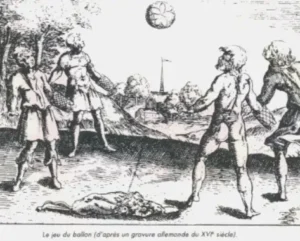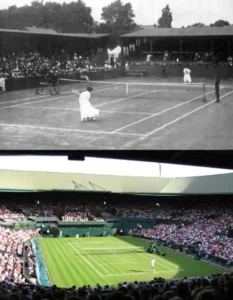Have you ever pondered the origins and beginnings of tennis? Like you, we too were curious, prompting us to delve into the annals of tennis history. As it turns out, the sport we cherish today embarked on a journey vastly different, evolving over countless centuries to reach its present form. Indeed, tennis’s lineage traces back a millennium, with some conjectures extending even further. So, what’s holding you back? Let’s embark on a voyage through the rich tapestry of tennis history!

The Complete Saga of Tennis’s Predecessors
The genesis of tennis has long sparked debate and speculation. While concrete evidence remains elusive, prevailing theories posit that an early incarnation of tennis emerged in the annals of Egypt, Greece, or Rome. Of course, this wasn’t during the era of cavemen. Fragmentary clues scattered amidst the cultures of these civilizations offer subtle hints. For instance, the term “racquet” likely derives from the Arabic “rahat,” signifying the palm of the hand, while “tennis” purportedly originates from the Egyptian town of Tinnis. Moreover, ancient engravings dating back to 1500 BC unearthed in Egypt depict a game akin to tennis, involving a ball volleyed over a net.
The earliest recorded instance of tennis’s forebear surfaced in the 11th or 12th century (around 1000 AD). Originating in France, French monks devised a courtyard ball game christened Jeu de Paume, translating to “game of the hand.” Another hypothesis suggests that the French term “tenez,” meaning “take heed,” “to take,” “hold,” or “receive,” birthed the moniker “tennis.” Players would vocally prompt “tenez” before serving, a ritual intertwined with religious ceremonies. Jeu de Paume’s rules and scoring, albeit more intricate, bear semblance to contemporary tennis.
The sport garnered widespread acclaim, spreading its roots across Europe. Initially dubbed Jeu de Paume before the advent of racquets, playing venues transitioned from courtyards to indoor courts, where balls still rebounded off walls. A revelation ensued with the realization that leather gloves facilitated ball contact more effectively than bare hands, culminating in the advent of wooden paddles—an innovation hailed as the dawn of the racquet.
The Emergence of True Tennis
By the 13th century, France boasted a reported tally of 1800 courts, testament to the sport’s burgeoning popularity. Attempts by Pope and Louis IV to outlaw tennis in France proved futile, as nobles like Henry VII (1413-22) and Henry VIII (1509-47) enthusiastically embraced the game upon its arrival in England. Over time, racquet design evolved, with the standardization of equipment by 1500—an amalgamation of sheep gut strings encased in a wooden frame, resembling a squash racquet. The transition from wall-bound play to net-based competition ushered in the nomenclature “tennis” in English, later dubbed “real tennis” to distinguish it from its modern counterpart.

The saga of tennis continued with the codification of rules in 1599, fueling the sport’s meteoric rise across Europe. Nobility from France, Spain, Italy, the Netherlands, and the Habsburg Empire fervently engaged in the game throughout the 17th century. However, Puritanical sentiments in the English realm, associating tennis with gambling, precipitated a decline. The tumultuous Age of Napoleon in the 1700s saw European royal families besieged, heralding the near demise of true tennis. Concurrently, England birthed new racquet sports like squash and rackets.
A brief renaissance of true tennis in Victorian England was overshadowed by the advent of “lawn tennis,” favored for its simplicity and inclusivity—welcoming female participants, a rarity in true tennis’s male-dominated realm.
The Advent of Lawn Tennis
A pivotal yet often overlooked milestone occurred in 1850 with Charles Goodyear’s invention of the vulcanization process for rubber—a transformative development in tennis history. The advent of bouncier rubber balls on grass ensued, paving the way for the next epoch.
In 1873, Welsh inventor and British army officer Walter Clopton Wingfield patented “Sphairistikè” (Greek for “skill in playing at ball”), a game borrowing heavily from true tennis—bearing striking resemblance to its modern iteration. Equipment comprised rubber balls, racquets, and hourglass-shaped grass courts, with taller nets and smaller dimensions. Although Wingfield coined “Sphairistikè,” its grass court setting led to widespread adoption of the term “lawn tennis.” Criticism and patent woes prompted Wingfield to relinquish control, allowing others to nurture the game’s evolution.
Following a fortuitous encounter with lawn tennis in Bermuda, Mary Ewing Outerbridge introduced the sport to the United States in 1874, erecting a court at the State Island Cricket and Baseball Club in New York. American enthusiasm for the sport burgeoned swiftly.
The inaugural Wimbledon tennis tournament in 1877 at the All England Club Croquet heralded a new era, unveiling the rectangular court that defines modern tennis. The tournament’s resounding success prompted the club’s rechristening as the All England Croquet and Lawn Tennis Club. Save for the adoption of the tie-break rule in 1971, tennis history has remained largely unaltered since 1877.
Expanding the Narrative: Further Insights into Tennis’s Evolution
As we traverse the historical landscape of tennis, it’s crucial to delve deeper into its multifaceted evolution. Beyond the delineated milestones lies a tapestry interwoven with myriad influences, innovations, and individuals that have shaped the sport we know today.
One pivotal aspect worth exploring is the cultural diffusion of tennis across continents and societies. From its humble origins in European monasteries and aristocratic courts, tennis transcended geographical boundaries, captivating diverse populations and weaving itself into the fabric of global sporting culture. The proliferation of tennis clubs, tournaments, and grassroots initiatives catalyzed its democratization, empowering enthusiasts of all backgrounds to partake in the sport’s joys and challenges.

Moreover, the technological advancements and material innovations that have revolutionized tennis equipment and infrastructure deserve closer scrutiny. From the rudimentary wooden paddles of yore to the state-of-the-art carbon fiber racquets and cushioned court surfaces of today, the evolution of tennis gear reflects a relentless quest for performance enhancement and player comfort. Similarly, the architectural evolution of tennis venues—from rudimentary clay courts to sprawling stadium complexes—mirrors the sport’s ascendancy from niche pastime to global spectacle.
Socio-cultural
Furthermore, an exploration of the socio-cultural dimensions of tennis unveils a tapestry of narratives encompassing gender equity, inclusivity, and social mobility. From the historic battles for gender parity in prize money and playing opportunities to the transformative impact of tennis on marginalized communities, the sport has served as a catalyst for social change and empowerment. By amplifying diverse voices and embracing inclusivity, tennis has transcended its elitist origins, emerging as a beacon of diversity and unity on the global stage.
In essence, the history of tennis is a testament to human ingenuity, resilience, and passion. As we navigate the labyrinthine corridors of time, let us celebrate the enduring legacy of this beloved sport and continue to champion its values of excellence, inclusivity, and fair play for generations to come.
